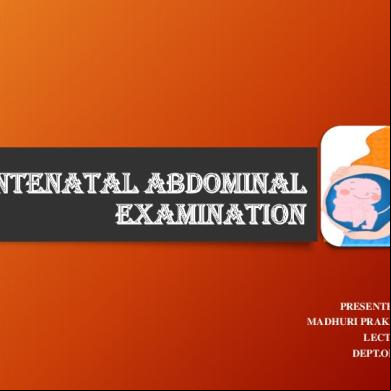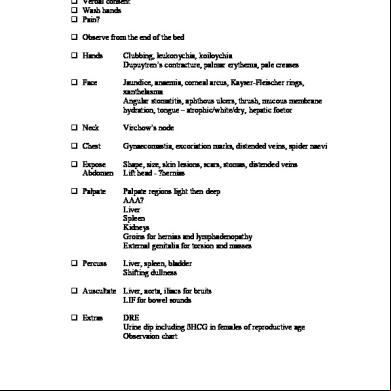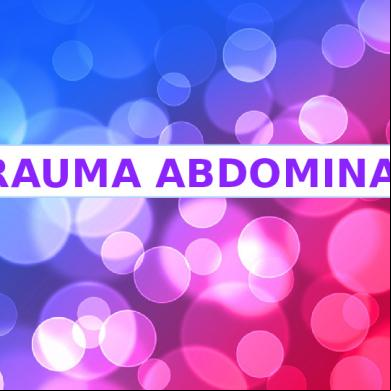Antenatal Abdominal Examination 1r3m39
This document was ed by and they confirmed that they have the permission to share it. If you are author or own the copyright of this book, please report to us by using this report form. Report 2z6p3t
Overview 5o1f4z
& View Antenatal Abdominal Examination as PDF for free.
More details 6z3438
- Words: 1,050
- Pages: 25
ANTENATAL ABDOMINAL EXAMINATION PRESENTED BY: MADHURI PRAKASH.R LECTURER DEPT.OF OBG
INTRODUCTION • A through and systemic abdominal examination beyond 28 weeks of pregnancy can reasonably diagnose.., 1. The lie 2. Presentation of the fetus 3. Position, 4. And attitude of the fetus. It is not unlikely that the position o fthe fetus might change, especially in association with excess liquor amnii and hence periodic check up is essential.
PRELIMINARIES verbal consent for examination is taken. the patient is asked to evacuate the bladder.{A full bladder will make the examination uncomfortable and can reduce the accuracy of the fundal height measurement} she is then made to lie in dorsal position with thighs slightly flexed.[The woman should be encouraged to lie with her arms by her sides to aid relaxation of the abdominal muscles.]
Place a wedge under the right buttock if the gravid uterus is of a size likely to compromise maternal and/or fetal circulation.[Pelvic tilt prevents occurrence of supine hypotension resulting from the weight of the gravid uterus obstructing the inferior vena cava – reducing venous return and hence cardiac output.] abdomen is fully exposed. the examiner stands on the right sid of the patient.
INSPECTION Note the abdominal size.
A full bladder, distended colon, or maternal obesity may effect estimation of fetal size
Observe the abdominal shape.
An abdominal shape that is longer than it is wide indicates a longitudinal lie. However, a shape that is low and broad may point to a transverse lie. The primigravid uterus is ovoid in shape compared to the multigravid uterus, which is a rounded shape. Dips and curves in the uterus may indicate fetal position
Inspect the abdomen for Presence of scars may indicate scars. abdominal or obstetric surgery
Examine the skin.
Observe for movements.
previous
Hormonal influences in pregnancy can cause striae gravidarum, hyperpigmentation, changes in nails, hair, and the vascular system. Striae gravidarum caused by physical and hormonal influences is more common in younger women, those with higher body mass indices, and in women carrying larger babies.
fetal Visible external fetal movements may be visible
PALPATION Estimating gestational age
Palpate of the abdomen by using the physical landmarks of the xiphisternum, the umbilicus and the symphysis pubis. Macrosomia, multiple pregnancy and small for gestation age may be detected by palpation and measurement of fundal height. Current evidence does not indicate that either the palpation method, or measurement of fundal height method, is superior to each other for detection of abnormal fetal growth. If a small for gestational age fetus is suspected, then confirmation of the estimated gestational age should be revisited.
Measure the fundal height with the tape measure from 24 weeks gestation.
Between 20 to 34 weeks gestation the height of the uterus correlates closely with measurements in centimetres, however maternal obesity has been shown to distort the accuracy of these measurements
FUNDAL PALPATION Both hands are gently placed around the fundus to determine contours of the fetus.
Aids determination of presentation, whether cephalic or breech. This will aid diagnosis of the lie and presentation of the fetus.
The whole of the fundal area is palpated using both hands laid flat on it to find out which pole of the fetus is lying in the fundus. Broad,soft and irregular mass suggestive of breech. Smooth,hard and globular mass suggestive of head. In transverse lie, neither of the fetal poles are palpated in the fundal area
LATERAL PALPATION Hands are placed at umbilicus level on either Location of the fetal side of the uterus. Gentle pressure is used with back can help determine each hand to determine which side offers the the fetal position. greatest resistance. ‘Walking’ the fingers over the abdomen can also locate the position of the back and distinguish fetal body parts. The back is suggested by smooth curved and resistent feel. The limb side is comparatively empty and there are small knob like irregular parts. After idetification of the back,it is essential to note its position whether placed anteriorly or towards the flank or placed transversely. Similarly the disposition of the smaller parts are also to be noted.
PELVIC PALPATION
Pelvic Palpation Ask the A woman in a relaxed woman to bend her knees position is less likely to tense slightly and encourage gentle abdominal muscles. breathing exercises.
PAWLIK’S GRIP/THIRS LEOPOLD The examination is done facing towards the patients face. The overstretched thumb and four fingers of the right hand are placed over the lower pole of the uterus keeping the ulnar border of the palm on the upper border of the symphysis pubis. When the fingers and the thumb are approximated,the presenting part is grasped distinctly[if not engaged] and also the mobility from side to side id tested. In transverse lie the pawlik’s grip is empty.
PELVIC GRIP/FOURTH LEOPOLD • The examination is done facing the patients feet. • Four fingers of both the hands are placed on the either side of the midline in the lower pole of the uterus and parellel to the inguinal ligament. • The fingers are pressed downward and backward in a manner of approximation of finger tips to palpate the part occupying the lower pole of the uterus. • If it is head,the charecteristics noted are.., 1. Precise presenting part 2. Attitude and 3. engagement
• To ascertain the presenting part, the greater mass of the head[cephalic prominence] is carefully palpated and its relation to the limbs and the back is noted. • The ATTITUDE of the head is inferred by noting the relative position of the sincipital and occipital poles. • The ENGAGEMENT is ascertained noting the presence or absence of the sincipital and the occipital pole or whether there is convergence or divergence of the finger tips during palpate.
AUSCULTATION • Auscultation of distinct fetal heart sounds not only helps in the diagnosis of the live baby, but its location of maximum intensity can also resolve doubt about the presentation of the fetus. • The FHR are best audible through the back in vertex and breech presentation, where the concave portion of the back is in with the uterine wall. • As a rule, the maximum intensity is below the umbilicus in cephalic presentation and around the umbilicus in breech.
INTRODUCTION • A through and systemic abdominal examination beyond 28 weeks of pregnancy can reasonably diagnose.., 1. The lie 2. Presentation of the fetus 3. Position, 4. And attitude of the fetus. It is not unlikely that the position o fthe fetus might change, especially in association with excess liquor amnii and hence periodic check up is essential.
PRELIMINARIES verbal consent for examination is taken. the patient is asked to evacuate the bladder.{A full bladder will make the examination uncomfortable and can reduce the accuracy of the fundal height measurement} she is then made to lie in dorsal position with thighs slightly flexed.[The woman should be encouraged to lie with her arms by her sides to aid relaxation of the abdominal muscles.]
Place a wedge under the right buttock if the gravid uterus is of a size likely to compromise maternal and/or fetal circulation.[Pelvic tilt prevents occurrence of supine hypotension resulting from the weight of the gravid uterus obstructing the inferior vena cava – reducing venous return and hence cardiac output.] abdomen is fully exposed. the examiner stands on the right sid of the patient.
INSPECTION Note the abdominal size.
A full bladder, distended colon, or maternal obesity may effect estimation of fetal size
Observe the abdominal shape.
An abdominal shape that is longer than it is wide indicates a longitudinal lie. However, a shape that is low and broad may point to a transverse lie. The primigravid uterus is ovoid in shape compared to the multigravid uterus, which is a rounded shape. Dips and curves in the uterus may indicate fetal position
Inspect the abdomen for Presence of scars may indicate scars. abdominal or obstetric surgery
Examine the skin.
Observe for movements.
previous
Hormonal influences in pregnancy can cause striae gravidarum, hyperpigmentation, changes in nails, hair, and the vascular system. Striae gravidarum caused by physical and hormonal influences is more common in younger women, those with higher body mass indices, and in women carrying larger babies.
fetal Visible external fetal movements may be visible
PALPATION Estimating gestational age
Palpate of the abdomen by using the physical landmarks of the xiphisternum, the umbilicus and the symphysis pubis. Macrosomia, multiple pregnancy and small for gestation age may be detected by palpation and measurement of fundal height. Current evidence does not indicate that either the palpation method, or measurement of fundal height method, is superior to each other for detection of abnormal fetal growth. If a small for gestational age fetus is suspected, then confirmation of the estimated gestational age should be revisited.
Measure the fundal height with the tape measure from 24 weeks gestation.
Between 20 to 34 weeks gestation the height of the uterus correlates closely with measurements in centimetres, however maternal obesity has been shown to distort the accuracy of these measurements
FUNDAL PALPATION Both hands are gently placed around the fundus to determine contours of the fetus.
Aids determination of presentation, whether cephalic or breech. This will aid diagnosis of the lie and presentation of the fetus.
The whole of the fundal area is palpated using both hands laid flat on it to find out which pole of the fetus is lying in the fundus. Broad,soft and irregular mass suggestive of breech. Smooth,hard and globular mass suggestive of head. In transverse lie, neither of the fetal poles are palpated in the fundal area
LATERAL PALPATION Hands are placed at umbilicus level on either Location of the fetal side of the uterus. Gentle pressure is used with back can help determine each hand to determine which side offers the the fetal position. greatest resistance. ‘Walking’ the fingers over the abdomen can also locate the position of the back and distinguish fetal body parts. The back is suggested by smooth curved and resistent feel. The limb side is comparatively empty and there are small knob like irregular parts. After idetification of the back,it is essential to note its position whether placed anteriorly or towards the flank or placed transversely. Similarly the disposition of the smaller parts are also to be noted.
PELVIC PALPATION
Pelvic Palpation Ask the A woman in a relaxed woman to bend her knees position is less likely to tense slightly and encourage gentle abdominal muscles. breathing exercises.
PAWLIK’S GRIP/THIRS LEOPOLD The examination is done facing towards the patients face. The overstretched thumb and four fingers of the right hand are placed over the lower pole of the uterus keeping the ulnar border of the palm on the upper border of the symphysis pubis. When the fingers and the thumb are approximated,the presenting part is grasped distinctly[if not engaged] and also the mobility from side to side id tested. In transverse lie the pawlik’s grip is empty.
PELVIC GRIP/FOURTH LEOPOLD • The examination is done facing the patients feet. • Four fingers of both the hands are placed on the either side of the midline in the lower pole of the uterus and parellel to the inguinal ligament. • The fingers are pressed downward and backward in a manner of approximation of finger tips to palpate the part occupying the lower pole of the uterus. • If it is head,the charecteristics noted are.., 1. Precise presenting part 2. Attitude and 3. engagement
• To ascertain the presenting part, the greater mass of the head[cephalic prominence] is carefully palpated and its relation to the limbs and the back is noted. • The ATTITUDE of the head is inferred by noting the relative position of the sincipital and occipital poles. • The ENGAGEMENT is ascertained noting the presence or absence of the sincipital and the occipital pole or whether there is convergence or divergence of the finger tips during palpate.
AUSCULTATION • Auscultation of distinct fetal heart sounds not only helps in the diagnosis of the live baby, but its location of maximum intensity can also resolve doubt about the presentation of the fetus. • The FHR are best audible through the back in vertex and breech presentation, where the concave portion of the back is in with the uterine wall. • As a rule, the maximum intensity is below the umbilicus in cephalic presentation and around the umbilicus in breech.










